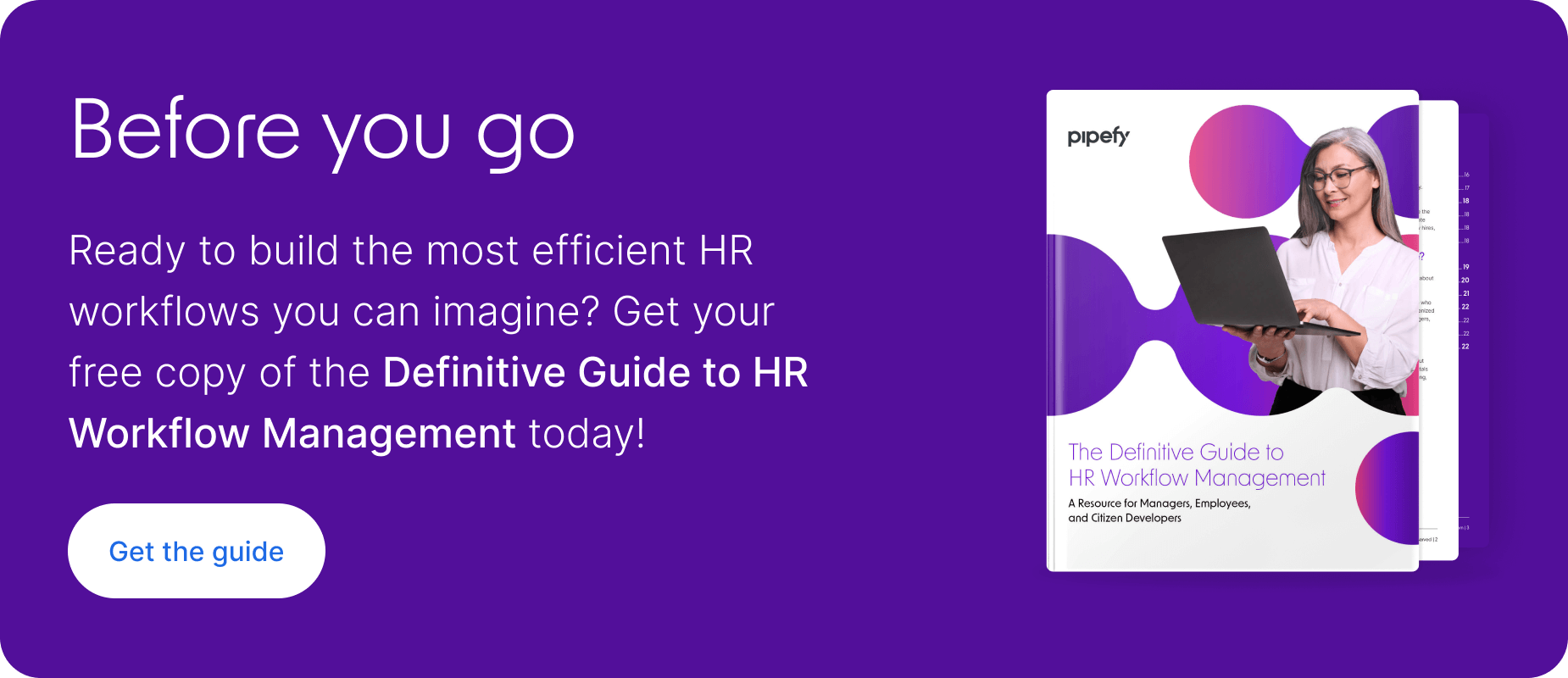ARTICLE SUMMARY
Agile HR effectively improves organizational performance and competitiveness by responding to problems quickly, strategically, and in a way that drives value for both employees and the company at large.

Agile is a project management methodology created to develop software in short cycles (or phases) of work. Agile methodology prioritizes a single goal: adding more value to the final product by reducing delivery times.
This is achieved with a problem-solving framework that maximizes speed, cost-effectiveness, and flexibility. This phased style of development breaks down big projects into smaller projects that allow teams to continuously evaluate and improve the final product as it’s being completed. By adapting to changes or needs as they arise, bureaucratic bottlenecks that come with traditional development are eliminated.
This prioritization of flexibility over bureaucracy is why the agile methodology is a perfect solution for HR departments striving to be more responsive to change and deliver more value to employees.
What is agile HR?
Human resource management (HRM) is a strategic approach to overseeing, supporting, and managing the people that make up a company. The purpose of HRM is to create a workplace culture that encourages productivity and overall alignment with the company’s mission, values, and goals. Agility is the ability to move, think, and make decisions quickly. Working agile is delivering more value in less time.
Agile HR applies the agile methodology and mindset to HR functions to effectively improve organizational performance and competitiveness by responding to problems quickly, strategically, and in a way that drives value for both employees and the company at large.
The 8 key characteristics of agile HR
- Adaptability: Agile HR thrives in dynamic environments, readily adjusting to changes in business needs, industry trends, and workforce dynamics.
- Flexibility: It embraces flexibility in processes, roles, and approaches, allowing for quick responses to emerging challenges and opportunities.
- Collaboration: Agile HR emphasizes cross-functional collaboration, encouraging teams to work together to address complex issues and drive innovative solutions.
- Continuous improvement: It prioritizes ongoing learning and enhancement, consistently seeking ways to optimize processes, strategies, and employee experiences.
- Employee empowerment: Agile HR involves employees in decision-making, values their input, and encourages them to take ownership of their development.
- Rapid decision-making: Agile HR empowers teams to make swift decisions, enabling timely responses to evolving situations and minimizing bureaucratic delays.
- Data-driven insights: It leverages data analytics to gain insights into workforce trends, enabling informed decision-making and strategy development.
- Iterative approach: Agile HR follows an iterative approach, experimenting with new methods, gathering feedback, and making adjustments to enhance outcomes.
What is the difference between traditional HR and agile HR?
Traditional HR practices have long been structured, hierarchical, and standardized, prioritizing stability, policy compliance, and uniformity. Traditional HR departments follow a top-down approach, with strategic decisions made at higher management levels and implemented throughout the organization.
Roles within traditional HR tend to be specialized, with professionals handling specific functions such as recruitment, benefits administration, or employee relations. The traditional HR mindset values predictability and stability, often being cautious about introducing changes that could disrupt established routines.
On the other hand, Agile HR represents a new way of thinking about HR functions, emphasizing adaptability, flexibility, and rapid response to change. Agile HR promotes cross-functional collaboration and decentralized decision-making, allowing for quicker, data-driven decisions.
This approach acknowledges the unpredictable nature of the modern business landscape and embraces a more iterative, experimental, and collaborative way of working. In agile HR, cross-functional collaboration is emphasized, with teams consisting of members from various HR disciplines working together to address complex challenges.
In conclusion, the difference between traditional HR and agile HR lies in their fundamental philosophies and operational methodologies. Traditional HR values stability and hierarchy, while agile HR values adaptability and collaboration. Organizations must decide which approach aligns with their culture and strategic objectives to navigate the ever-changing business landscape.
Why is agile HR important?
In business, agility is the difference between staying competitive and becoming irrelevant. Organizational agility is needed for success and agile HR is a key partner in creating that.
By tackling large problems (like employee retention/turnover) as smaller, more manageable tasks similar to short cycles of work, HR teams are able to adapt plans as obstacles and new needs arise, and develop and deploy solutions that have a direct impact on employees.
Business, department, and employee benefits
Human resources departments are one of the most vulnerable to bureaucracy, excessively long processes, and top-down solutions. Over time, this taxing cycle can have a negative impact on the company that may take the form of:
- Problems with employee morale
- Poor employee experiences
- Long time-to-hire windows
- Communication silos
- High turnover rates
- Under-resourced departments
- Tedious employee management, rather than strategic empowerment and support
By making the agile methodology the foundation of your company’s human resources management, HR associates and specialists can become better equipped to handle rapidly changing company needs by continuously identifying problems, solutions, and improvements — a win-win for all employees. Other tangible benefits include:
- Motivated employees
- Higher employee engagement and satisfaction
- Improved workplace culture
- More strategic collaboration between HR and leadership
- Better final product or service
- Shorter time-to-hire
- Improved employee experiences
During a time when employees and candidates want and expect more from employers, finding ways to get ahead of business challenges and cultivate a work environment that attracts qualified talent and retains top-performing employees is key. Agile HR can help with that.
Examples of agile HR
- Agile recruitment
- Adaptive learning and development
- Dynamic job roles
Agile recruitment
Agile recruitment is a modern approach to hiring that transforms traditional processes into dynamic and responsive systems. This strategy focuses on a candidate’s skills and potential rather than rigid qualifications, widening the talent pool and accommodating those with unique perspectives and adaptable qualities.
Additionally, data-driven sourcing plays a pivotal role, utilizing advanced analytics to identify the most effective channels for attracting and engaging potential candidates.
Agile recruitment also encourages evolving interview formats, allowing for ongoing adjustments based on candidate feedback to ensure a fair evaluation and optimize the experience. A rapid feedback loop is established among stakeholders, enabling prompt assessments of candidate suitability and quick adjustments to the recruitment strategy.
Adaptive learning and development
Adaptive learning and development cater to the individualized needs of employees while aligning with the organization’s changing demands. This approach creates personalized learning paths that are tailored to an employee’s skills, career aspirations, and preferred learning style, making learning relevant, engaging, and directly applicable to their roles.
Micro-learning modules serve as the foundation of adaptive learning, offering bite-sized units of learning content that are available on-demand, allowing employees to acquire knowledge quickly when they need it.
Another crucial aspect of adaptive learning is a continuous feedback loop, allowing employees and managers to contribute insights to refine learning content, making it more pertinent and valuable over time.
Dynamic job roles
Dynamic job roles are designed to be versatile and adaptable, reflecting the fast-paced nature of modern workplaces. These roles emphasize cross-functional collaboration, enabling employees to work across departments, share expertise, and contribute to projects that span different functions, fostering a holistic understanding of the organization’s operations.
Dynamic roles promote career mobility within the organization, encouraging employees to explore different paths, leveraging their existing skills and acquiring new ones along the way. This approach nurtures a culture of continuous learning and adaptability, fostering a workforce that can readily respond to evolving challenges and opportunities.
5 ways HR can become more agile
HR departments are easily bogged down by bureaucracy, which can lead to a fragmented, tedious, and inefficient experience for all stakeholders, both internal and external. To become more agile, HR teams, along with other leaders within a company, should seek to deliver more value in less time and provide talent with the best possible employee experience.
When applied to HR principles, the agile methodology gives HR teams the flexibility to test new, innovative ways of running processes in order to become more responsive, adaptive, and people-centered.
Here are five practical ways to guide your HR department toward a more agile way of working:
- Connect with employees to define problems and create solutions
- Streamline and standardize workflows with low-code BPA
- Focus on continuous employee development
- Don’t forget to valorize all employees
- Execute, evaluate, improve, and repeat
1. Connect with employees to define problems and create solutions
Before really diving into improvements, it’s important to first understand what the problem is. As a starting point, go to the people who are affected by HR processes: the employees.
Whether you want to conduct 1:1 interviews with managers or share a feedback survey with employees, solving the problem(s) begins with creating a detailed roadmap of existing HR processes and highlighting every pain point, bottleneck, and missing step that keeps the HR team from cultivating a people-first experience and being an agile and strategic partner.
Learn more: What Is HR Process Mapping? Benefits, Illustrations, and How to Do It
2. Streamline and standardize workflows with low-code BPA
Low-code HR automation software makes it easier for users to build, modify, and standardize their processes, all without any coding experience. Low-code automation resolves the familiar tension between the HR team’s need for agility and the IT team’s need for control of security.
With low-code automation, business users can set rules and events that trigger specific actions in a process as a way to streamline high-volume, repetitive tasks. For HR teams, this can be a significant relief and an opportunity to refocus the time and energy spent on admin work toward more strategic, people-first work.
Business process automation also reduces risk by standardizing HR processes, making it easier for HR to enforce company policies and for IT to ensure security and compliance measures are met across the entire org.
Here are 10 essential BPA features and benefits HR teams can leverage to help streamline and standardize HR workflows:

3. Focus on continuous employee development
At a non-agile company, employee development programs are obscure, infrequent, and lack standardization which can leave employees wondering whether they’re doing a good job or not – or worse, leading them to start searching for a new job.
Data shows that employees that receive constructive, frequent, and focused feedback are more likely to remain engaged in their role and be motivated to do better. But in order to receive this sort of feedback, it’s up to HR to create a clearly defined, frequent, and standardized feedback evaluation process that focuses not on the thing that employees are doing wrong, but on how they can strengthen the things they are doing right.
Agile HR is all about growing in real-time, so motivating employees to take personal ownership in growing the company by developing themselves and taking on opportunities to upskill is a win-win for retention and engagement.
4. Don’t forget to valorize all employees
A primary function of HR is making sure that all team members are aligned and working toward the company’s goals. An agile HR takes that idea and brings it to life by making every single member of the company aware of their contribution to the final product or service offered. Everyone should work toward the same goal and it is agile HR’s role to encourage this.
5. Execute, evaluate, improve, and repeat
The agile methodology encourages teams to bring the most value to the final product by continuously evaluating and improving HR processes throughout each phase of a project. Agile HR teams should do the same.
By maintaining the flexibility to analyze, improve, and adapt to company changes, HR teams become more people-centered and are able to cultivate an engaging employee experience.
FAQ about agile HR
What is the leadership model in agile HR?
In agile HR, the leadership model shifts from traditional top-down hierarchies to one that fosters collaboration, empowerment, and continuous learning. Leaders become facilitators who inspire and guide teams, promoting open communication, quick decision-making, and a culture of experimentation.
What is the agile mindset in agile HR?
The agile mindset in agile HR embodies a set of values and principles that prioritize adaptability, collaboration, and continuous improvement. It involves being open to change, embracing uncertainty, and valuing iterative learning.
What is the role of HR in agile transformation?
In agile transformation, HR facilitates cultural change, develops agile leaders, supports talent acquisition and development, adjusts performance management, enhances employee engagement, influences organizational structure, and much more.
Is Scrum useful for agile HR?
Yes, Scrum can be useful for agile HR. It provides a structured framework for managing projects and tasks, enhancing collaboration, transparency, and adaptability within HR teams. Scrum’s iterative approach aligns well with agile principles, allowing HR to deliver value quickly, receive feedback, and make necessary adjustments.
Is Kanban useful for agile HR?
Yes, Kanban is beneficial for agile HR. It aids in visualizing agile workflows, managing tasks, and promoting continuous improvement. Kanban’s focus on flow and flexibility aligns with HR’s need for adaptive processes, enabling teams to streamline work, prioritize tasks, and respond promptly to changing demands.






